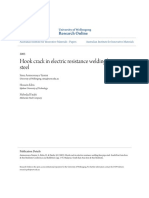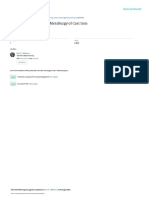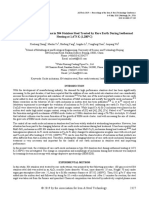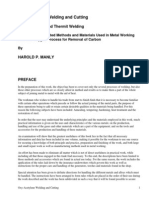Spark Test For Iron Steel
Spark Test For Iron Steel
Uploaded by
Tegar Kukuh Ahmad JulfikarCopyright:
Available Formats
Spark Test For Iron Steel
Spark Test For Iron Steel
Uploaded by
Tegar Kukuh Ahmad JulfikarOriginal Description:
Original Title
Copyright
Available Formats
Share this document
Did you find this document useful?
Is this content inappropriate?
Copyright:
Available Formats
Spark Test For Iron Steel
Spark Test For Iron Steel
Uploaded by
Tegar Kukuh Ahmad JulfikarCopyright:
Available Formats
Guide to Historic Iron & Steel Structures
APPENDIX
E SPARK TEST OF METALS
E.1 BACKGROUND
Ferrous metals can be roughly classified by observing the sparks given off when the surface of the
metal is touched by a high-speed grinding wheel. This method was originally developed
systematically in the early part of the 20th century.
On iron and steel bridges, this simple method can be used to rapidly categorize the relative carbon
content of the different structural members, such as pins, eyebars, and rolled sections.
Chemical elements in the metal influence the appearance of the spark stream. Pure iron exhibits a
drop or bud formation near the end of the spark stream, without branching or bursting. Carbon
causes the spark stream to burst. At carbon contents in the range 0.05 to 0.08 percent, there are only
a few bursts visible in the stream, and the number of lines in each burst is two to three. As the
carbon content increases, the number of bursts, and the number of lines in each burst increase.
E.2 PROCEDURES
A portable grinder capable of achieving at least 4500-feet per minute at the wheel edge is required.
For example a portable 4.5-inch angle grinder running at 6500-rpm, or a small cordless high-speed
rotary tool with a ½-inch disk at 35,000-rpm, can be used.
Both the grinding wheel and the metal being tested must be clean. If not, the contaminants will
alter the spark character. Remove paint and rust in the area of the metal to be tested. Then dress the
grinding wheel using a dressing tool.
Spark steams can be photographed successfully with a digital camera (flash turned off). Best results
are obtained on an overcast day, or at dawn or dusk. Use a matt-finish black or dark gray fire-
resistive board as a background for the sparks.
E.3 REFERENCE DIAGRAMS AND SAMPLES
Most welding textbooks contain spark diagrams for common ferrous metals. Spark Atlas of Steels
(Tschorn) published in translation in 1963 contains a comprehensive study of carbon steels and
alloys, and provides color images correlated with chemical analysis and cross-referenced to U.S.
and European steel standards.
For practical field use, it is best to have a set of samples with known material type and chemical
analysis. The spark characteristics can then be compared directly with the unknown material on the
bridge.
Sparks Engineering, Inc. December 2004
Page E-1
Guide to Historic Iron & Steel Structures
APPENDIX
Figure A.1 Spark patterns for ferrous metals, Norton Abrasives
Figure A.2 Truss diagonal with 0.08% carbon content Figure A.3 Pin with 0.19% carbon content
Sparks Engineering, Inc. December 2004
Page E-2
Guide to Historic Iron & Steel Structures
APPENDIX
E.4 BIBLIOGRAPHY
The Lincoln Electric Company, New Lessons in Arc Welding, various editions beginning 1940.
Tschorn, Gerhart, Spark Atlas of Steels: Cast-Iron, Pig-Iron, Ferro-Alloys and Metals, The
MacMillan Company, New York, 1963. This book is out of print, and is not generally available
from used book dealers. However, many major university libraries have a copy and it can be
obtained through Inter-Library Loan.
Sparks Engineering, Inc. December 2004
Page E-3
You might also like
- Analysis of The Opening Paragraph of The Fall of The House of UsherDocument3 pagesAnalysis of The Opening Paragraph of The Fall of The House of Usherprajwal100% (2)
- Physical Metallurgy of SteelDocument219 pagesPhysical Metallurgy of SteelNataliya Kompaniyets-Jouri100% (1)
- Exp7 Metal CorrosionDocument21 pagesExp7 Metal CorrosionArisha Ruzalani100% (1)
- 1485 Digital Breast TomosynthesisDocument156 pages1485 Digital Breast TomosynthesisWinston Mauricio Casco Sobalvarro100% (1)
- DEO Officer's Manual PDFDocument216 pagesDEO Officer's Manual PDFSergio Roberto CavalcanteNo ratings yet
- Orcish Name TablesDocument94 pagesOrcish Name Tablesbalim01No ratings yet
- Winnie The Witch TextDocument4 pagesWinnie The Witch TextAntonela PezzellaNo ratings yet
- Spark Test of Metals: B B A ADocument4 pagesSpark Test of Metals: B B A ALovely NievesNo ratings yet
- Segregation Effects Iii Welded Stairless Steels: Pinstech/Npd-121Document26 pagesSegregation Effects Iii Welded Stairless Steels: Pinstech/Npd-121Lenin CórdovaNo ratings yet
- Copper and Tin in Steel Scrap RecyclingDocument15 pagesCopper and Tin in Steel Scrap RecyclingakshukNo ratings yet
- Extended Abstract (Wheel Sparks Cavite NHS)Document3 pagesExtended Abstract (Wheel Sparks Cavite NHS)api-283862617100% (2)
- m8 PDFDocument19 pagesm8 PDFAnonymous q07TFIys9No ratings yet
- YCChen08 AciergalvaniseDocument8 pagesYCChen08 Aciergalvanisearun_prasath_41No ratings yet
- Covered Welding ElectrodesDocument11 pagesCovered Welding ElectrodesAqsa BanoNo ratings yet
- Metallurgy and ArchaeologyDocument7 pagesMetallurgy and ArchaeologySidharthNo ratings yet
- Section 1. Identification of MetalsDocument4 pagesSection 1. Identification of MetalsrobinyNo ratings yet
- Acsr & AlloyDocument17 pagesAcsr & AlloyDev KumarNo ratings yet
- Laboratory Work No.4 - MetalsDocument13 pagesLaboratory Work No.4 - Metalsapartament11facturiNo ratings yet
- 2011 - Electrotechnical Anisotropic Steel. Part 1. History of Development - LOBANOVDocument8 pages2011 - Electrotechnical Anisotropic Steel. Part 1. History of Development - LOBANOVJPNo ratings yet
- Chapter 4. Metal Structure, Welding, and Brazing: 9/27/01 AC 43.13-1B CHG 1Document84 pagesChapter 4. Metal Structure, Welding, and Brazing: 9/27/01 AC 43.13-1B CHG 1RanggaNo ratings yet
- Engineering Materials-Chapter One-Ferrous Alloys HighlightedDocument32 pagesEngineering Materials-Chapter One-Ferrous Alloys HighlightedMohammed AssadNo ratings yet
- 1982AustSS FSWeldJntFalrs WeldJDocument11 pages1982AustSS FSWeldJntFalrs WeldJthisaintwapNo ratings yet
- ALUMINUM, Fabrication and Finishing Vol 3. American Society For MetalsDocument44 pagesALUMINUM, Fabrication and Finishing Vol 3. American Society For Metalsdanielgleza100% (1)
- Fabre, Mikaella Jean S. - bldgtc11 - Activity-Fn-02Document3 pagesFabre, Mikaella Jean S. - bldgtc11 - Activity-Fn-02fabre.mikaellaNo ratings yet
- Application Iron and Aluminum Electrodes in Emission Spectrograph For Analyzing Boron and Cadmium in Uranium Nuclear FuelDocument10 pagesApplication Iron and Aluminum Electrodes in Emission Spectrograph For Analyzing Boron and Cadmium in Uranium Nuclear FuelDian Michae SagalaNo ratings yet
- The Effect of Alloying and of The Structure On Active-Passive Transition Potential Range of 17% Chromium Ferritic Stainless SteelsDocument6 pagesThe Effect of Alloying and of The Structure On Active-Passive Transition Potential Range of 17% Chromium Ferritic Stainless SteelsBANUNo ratings yet
- Smith 2013Document7 pagesSmith 2013jhenyNo ratings yet
- Effect of Alumina Addition On Wel Deposit Microstructure at The Welding of Carbon SteelDocument7 pagesEffect of Alumina Addition On Wel Deposit Microstructure at The Welding of Carbon SteelPamuk Eda CeylanNo ratings yet
- ARC-Slag Remelting of Steel and AlloysDocument323 pagesARC-Slag Remelting of Steel and AlloysAlexiz Alvarado MendozaNo ratings yet
- Metallurgy and Steel Properties: Electron (-)Document10 pagesMetallurgy and Steel Properties: Electron (-)Ashish ManeNo ratings yet
- (Advances in Materials Science) Assessment of Fitness For Service of Cr-Mo Steel Tubes in Catalytic Reforming Charge HeatersDocument10 pages(Advances in Materials Science) Assessment of Fitness For Service of Cr-Mo Steel Tubes in Catalytic Reforming Charge HeatersM ANo ratings yet
- Lab ReportDocument5 pagesLab ReportOmaroMohsenNo ratings yet
- MT Steiner2010Document10 pagesMT Steiner2010Biraj SahooNo ratings yet
- Distribution of Metal Droplets in Top Slags During Ladle TreatmentDocument14 pagesDistribution of Metal Droplets in Top Slags During Ladle TreatmentRasul BzNo ratings yet
- Ferrous and Non-Ferrous Metals: Intended Learning OutcomesDocument83 pagesFerrous and Non-Ferrous Metals: Intended Learning OutcomesJingness StanNo ratings yet
- Thermo-Chemistry of Non-Metallic Inclusions in Ductile Iron: ArticleDocument15 pagesThermo-Chemistry of Non-Metallic Inclusions in Ductile Iron: ArticleMonish KumarNo ratings yet
- Hook Crack in ERWDocument11 pagesHook Crack in ERWN TanejaNo ratings yet
- 1990ASM - Handb - Vol1 - Classification and Basic Metallurgy of Cast IronDocument10 pages1990ASM - Handb - Vol1 - Classification and Basic Metallurgy of Cast IronFátima GouveiaNo ratings yet
- Corrosion-Resistant Component For PEM Fuel Cells: Shuo-Jen Lee, Ching-Han Huang, Jian-Jang Lai, Yu-Pang ChenDocument7 pagesCorrosion-Resistant Component For PEM Fuel Cells: Shuo-Jen Lee, Ching-Han Huang, Jian-Jang Lai, Yu-Pang ChenSoh Ming LunNo ratings yet
- Empirical Model of Residual Element Content in Steel When Three-Component Burden Is Used in The Process of Steel Production in Electric Arc FurnaceDocument6 pagesEmpirical Model of Residual Element Content in Steel When Three-Component Burden Is Used in The Process of Steel Production in Electric Arc FurnaceSEP-PublisherNo ratings yet
- Evolution of Oxide Inclusions in 304 Stainless Steel Treated by Rare Earth During Isothermal Heating at 1,473 K (1,200°C)Document6 pagesEvolution of Oxide Inclusions in 304 Stainless Steel Treated by Rare Earth During Isothermal Heating at 1,473 K (1,200°C)JJNo ratings yet
- Corrosion Brass, Steel and Brass Coated WiresDocument13 pagesCorrosion Brass, Steel and Brass Coated WiresMichaela JoanidisovaNo ratings yet
- Coated Electrodes or AIS 3Document10 pagesCoated Electrodes or AIS 3John JohnsonNo ratings yet
- The Effect of An Aluminum Tip in Arc Stud Welding On The Properties of The Welded JointDocument9 pagesThe Effect of An Aluminum Tip in Arc Stud Welding On The Properties of The Welded JointMiguelNo ratings yet
- Copper and Copper Alloys - R A WilkinsDocument376 pagesCopper and Copper Alloys - R A WilkinsFabio Fonceca de SousaNo ratings yet
- Cuestionario Materiales PDFDocument19 pagesCuestionario Materiales PDFJuan Diego CalderonNo ratings yet
- A Hot Cracking On Dissimilar Metal Weld Between A106GrB and A312 TP316L With Buttering ERNiCr-3Document16 pagesA Hot Cracking On Dissimilar Metal Weld Between A106GrB and A312 TP316L With Buttering ERNiCr-3kamal touilebNo ratings yet
- Corrosion of Aged and Annealed 18 Ni 250 Grade Maraging Steel in Phosphoric Acid MediumDocument16 pagesCorrosion of Aged and Annealed 18 Ni 250 Grade Maraging Steel in Phosphoric Acid MediumSharat ChandraNo ratings yet
- Failure Analysis at Deep Drawing of Low Carbon SteelsDocument7 pagesFailure Analysis at Deep Drawing of Low Carbon SteelsPaul RosiahNo ratings yet
- Materials Science in Semiconductor Processing: A. Ravi Sankar, S. DasDocument5 pagesMaterials Science in Semiconductor Processing: A. Ravi Sankar, S. DasportuanoNo ratings yet
- Oxy-Acetylene Welding and CuttingDocument96 pagesOxy-Acetylene Welding and CuttingGutenberg.orgNo ratings yet
- Experimental Study To Determine The Variation Over The Material While Exposed To Magnetic FieldDocument3 pagesExperimental Study To Determine The Variation Over The Material While Exposed To Magnetic FieldtheijesNo ratings yet
- A Review of The Electrochemical Corrosion Behaviour of Iron AluminidesDocument10 pagesA Review of The Electrochemical Corrosion Behaviour of Iron AluminidesNgọc Minh LêNo ratings yet
- Ferrous Metals and AlloysDocument42 pagesFerrous Metals and Alloysஎன் கருத்து100% (1)
- ASTM Paper Material Science and ManagementDocument19 pagesASTM Paper Material Science and ManagementMerviNo ratings yet
- Background of The StudyDocument18 pagesBackground of The StudyCely Marie VillarazaNo ratings yet
- THE Working of Steel: Page V Preface To Second EditionDocument207 pagesTHE Working of Steel: Page V Preface To Second EditionGutenberg.org100% (2)
- Chapter 11.-Electroslag Remelting of Copper and Its AlloysDocument2 pagesChapter 11.-Electroslag Remelting of Copper and Its AlloysJesús Francisco Vidaňa DuronNo ratings yet
- Corrosion Behaviour of Electrochemically Joined AlDocument7 pagesCorrosion Behaviour of Electrochemically Joined AlJohn TorrezNo ratings yet
- Laboratory Work No.4 - MetalsDocument12 pagesLaboratory Work No.4 - Metalsapartament11facturiNo ratings yet
- The Properties and Uses of Zinc MetalDocument9 pagesThe Properties and Uses of Zinc Metalshahin azNo ratings yet
- The Study of Elementary Electricity and Magnetism by Experiment: Containing Two Hundred ExperimentsFrom EverandThe Study of Elementary Electricity and Magnetism by Experiment: Containing Two Hundred ExperimentsNo ratings yet
- The Study of Elementary Electricity and Magnetism by Experiment: Containing Two Hundred Experiments Performed with Simple, Home-made ApparatusFrom EverandThe Study of Elementary Electricity and Magnetism by Experiment: Containing Two Hundred Experiments Performed with Simple, Home-made ApparatusNo ratings yet
- Ironwork - Part III - A Complete Survey of the Artistic Working of Iron in Great Britain from the Earliest TimesFrom EverandIronwork - Part III - A Complete Survey of the Artistic Working of Iron in Great Britain from the Earliest TimesNo ratings yet
- Unit 3: Section A Function Agreeing and DisagreeingDocument26 pagesUnit 3: Section A Function Agreeing and DisagreeingZahid ButtNo ratings yet
- ASSIGNMENT Robinson CrusoeDocument2 pagesASSIGNMENT Robinson CrusoeLaura Vegas CruzNo ratings yet
- ENGLESKI JEZIK - Vita Razina Probni Ispit 2023.-2024. Ogledni Primjeri EsejaDocument6 pagesENGLESKI JEZIK - Vita Razina Probni Ispit 2023.-2024. Ogledni Primjeri EsejaJan LakićNo ratings yet
- Kaluach PrintDocument1 pageKaluach PrintcleoniltonNo ratings yet
- How To Write LiteratureDocument2 pagesHow To Write Literaturetaman7676No ratings yet
- Fallout - New Vegas Skill BooksDocument5 pagesFallout - New Vegas Skill BooksJosé Luis Buenaño Durán100% (1)
- FLFLH - J Isl: ContemporaryDocument252 pagesFLFLH - J Isl: ContemporaryLeonardo Agrello MadrugaNo ratings yet
- The Vijaya Dashami StoryDocument8 pagesThe Vijaya Dashami StoryvlaxmananNo ratings yet
- 117 The False Anointed OnesDocument8 pages117 The False Anointed OneseugeneNo ratings yet
- Ishtar Rising: Why The Goddess Went To Hell and What To Expect Now That She's ReturningDocument6 pagesIshtar Rising: Why The Goddess Went To Hell and What To Expect Now That She's ReturningGo AwayNo ratings yet
- Marchs Advanced Organic Chemistry Reactions MechaDocument2 pagesMarchs Advanced Organic Chemistry Reactions MechaHunzalaNo ratings yet
- 11.1.21 KS1 English Paddington Week 1Document8 pages11.1.21 KS1 English Paddington Week 1lingua.science86No ratings yet
- Eric Storm Book SynopsisDocument7 pagesEric Storm Book SynopsiskdemarchiaNo ratings yet
- Goethe Wilhelm Meisters Lehrjahre PDFDocument3 pagesGoethe Wilhelm Meisters Lehrjahre PDFPeggyNo ratings yet
- Book List UpdatedDocument4 pagesBook List UpdatedSusan Paige Crocker MullisNo ratings yet
- Shelo Asani Aved - Relationship With God, Relationship With ManDocument8 pagesShelo Asani Aved - Relationship With God, Relationship With Manoutdash2No ratings yet
- Leslie Marmon Silkos Sacred WaterDocument4 pagesLeslie Marmon Silkos Sacred WaterDevidas KrishnanNo ratings yet
- Chaucer, Canterbury TalesDocument624 pagesChaucer, Canterbury TalesGabriel MitzraelNo ratings yet
- New Horizon of Public Administration by Mohit BhattacharyaDocument425 pagesNew Horizon of Public Administration by Mohit BhattacharyaAviroop Sinha79% (67)
- Level C - All Kinds of BoatsDocument2 pagesLevel C - All Kinds of Boatsapi-352706779No ratings yet
- Beyond Today Magazine - November/December 2018Document40 pagesBeyond Today Magazine - November/December 2018United Church of GodNo ratings yet
- Cocker's Decimal ArithmetickDocument1 pageCocker's Decimal ArithmetickAnonymous vcdqCTtS9No ratings yet
- Lesson 5Document6 pagesLesson 5api-381133614No ratings yet
- International Phonetic AlphabetDocument19 pagesInternational Phonetic AlphabetCamila Torres ReyesNo ratings yet
- National Artist of The Philippines in Literature: By: Charmaine mUNOZ, Perlyne Corioso Roger Visto, OLIVER GAMILLADocument16 pagesNational Artist of The Philippines in Literature: By: Charmaine mUNOZ, Perlyne Corioso Roger Visto, OLIVER GAMILLAAlleah Grace JuguanNo ratings yet

























































































